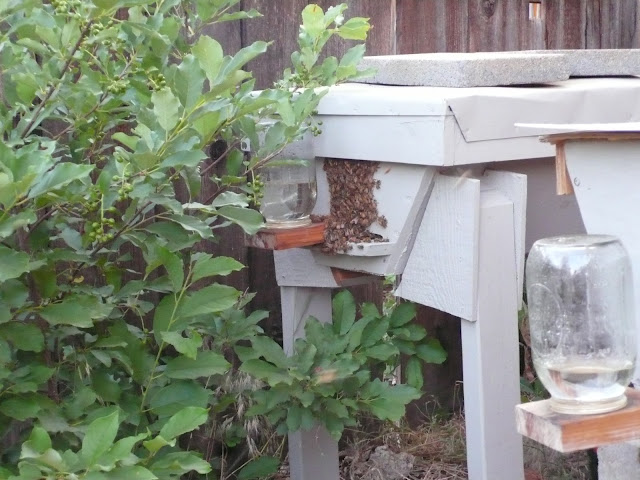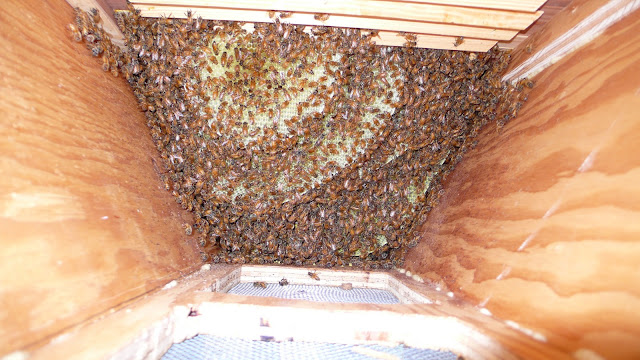Upon opening the hives this weekend, I decided they don't need supplementary food any more. So far I have fed them 30 lbs of sugar mixed in as much water (15 lbs of sugar per hive). $ 6.50 for a 10 lb bag of C&H cane sugar from Walmart. I have left the feeders on the hive but now they have straight water (to drink and cool the hive).
Yes, the bees are doing exactly what they should be doing, but I was still surprised to see how much furniture (comb) they had built. The brood nest is where the bees raise their young. It is located near the front of these hives. The brood nest is presently about 8 bars of drawn comb. The first bar, nearest the front of the hive is almost all pollen filled, then the next 8 contain the brood nest. In examining some of those bars it seems that there are a lot of the cells in the brood nest bars that have nectar or uncapped honey in them. I think this is somewhat normal as the nurse bees keep some nectar / honey close to feed the young. But I worry that there is too much up front and that the queen is running out of space for young. This is called honey bound. When that happens, swarming can happen. I'd rather error on the side of conservatism so I added an empty bar (no wax) in the brood nest area for the bees to draw out (build comb).
One of the shocking things I discovered was that the bees attached all the honey combs to the side walls of the hive. This meant that I had to cut each comb to remove and inspect it. This was a complete mess. Honey everywhere. Everything sticky, bees not to happy and yes stung hand (1 sting).
Here's a picture of a bar mostly full of honey (sun burst for effect). The bees cap the cells when the cells are full of honey whose moisture level has been reduced. (The other side looks the same). Notice how the cell for the most part are nowhere near the long edge of the bar, this is good. Also notice new pvc lined gloves (sting proof)!

You can see the comb getting close to the edge of this bar. That trouble and leads to it being attached across bars. It makes the bars hard to get out one at a time and when you try you tend to rip the comb, leak honey and annoy the bees. My remedy was to squish it back.
Yes this also mean honey on you fingers (gloves) and less than happy bees.
Here is a picture into the hive.
Capped honey near the top of the bar. On the right you can see remnants of wax attachment (brace comb). On the left wall near the bottom you can see broken comb. This is what happens when you try to remove a bar that is attached to the wall. This was a nice break in that it is very small. Here is a close up.
They clean it right up.
This is a different piece, in the above picture. I scrap out all I can and move on with the inspection. You can see they are still are fond of the honey.
Here is where I placed the empty bar, right between #12 and #5. You can tell, by the numbering of the bars, that I have been placing bars in the brood nest. This spreads it out and hopefully prevents swarming. The adjacent bars (#12 & #5) have really straight comb so by placing and empty bar between I'm almost guaranteed that the bees will build straight. The bees on top of bars 6 - 10 are sucking up honey drips. You can also see the spray bottle. Its filled with water and about 10 drops of lemongrass oil. This is supposed to settle the bees down. It smells better than smoke. Two days ago when I did more cutting of the comb to unstick the honey bars I ran out of scented water and the bees were already agitated so I had to resort to smoke from the smoker.
Here are the bits of wax (oops and a squished bee) that I scraped from the sides of the hive. Two days ago I cut out about half a bowl full of crocked comb, brace comb, cross comb. So not too bad this time.
I did find this fella, He's a drone (male bee) he is a little bigger than the girls and his eyes are really big and almost look like they touch one another. All the better to find the queen!




























